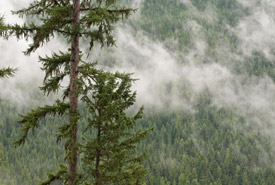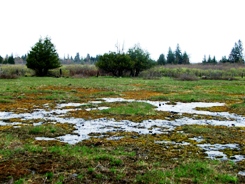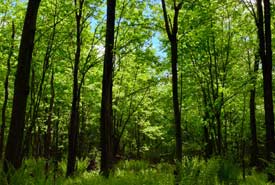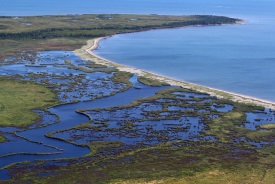Why no net loss in biodiversity offsets fails nature and people

Misty Darkwoods forest, BC (Photo by Bruce Kirkby)
There is a new conservation tool making its way through the forests, wetlands and boardrooms of Canada: biodiversity offsets. Biodiversity offsets offer an opportunity to mitigate development impacts to nature that cannot be otherwise avoided. They are kind of like your friend borrowing your car with a full tank of gas, and then making sure they fill it right back up before its return.
Biodiversity offsets build on traditional environmental assessment approaches and provide compensation for the loss of species and habitats that would otherwise have been completely lost. Although offsets are a relatively new tool in Canada, they have been widely used in other parts of the world for over 20 years. In some places, offsets are praised because they improve conservation outcomes. In others, offsets are criticized for reducing biodiversity by permitting unsustainable development projects.
Conservationists should be cautious about biodiversity offsets. If misused and misdirected, they have the potential to create a false illusion of sustainability. On the other hand, traditional approaches to economic development have failed many ecosystems and the people that rely on them. In a world that desperately needs different conservation outcomes, we need different conservation tools.
Canada is in the fortunate position of being able to improve on the experiences of other countries, and build on existing efforts such as the principles developed by the Business and Biodiversity Offset Program (BBOP). The BBOP principles are very sound, and an excellent starting point for national, provincial and corporate approaches to biodiversity offsets. They include some fundamental elements that need integration into any offset program.
Following the mitigation hierarchy is critical in ensuring that offsets are a last step in a process that should first try to avoid and mitigate any impacts. Limits to offsets require the identification of places, species and habitats that are too rare to lose and may be technically impossible to offset. The concept of additionality (i.e. beyond business as usual) ensures that we are creating conservation outcomes that would not have otherwise occurred without the offset.
Although the BBOP principles provide the foundation for an effective offset program, they fall short on one key standard: no net loss. This is because, despite best intentions, attempts at no net loss have failed, and ultimately result in degraded habitats and declines of species. The consequences of these losses are significant because the development project and offset are often occurring in landscapes that already have experienced significant ecological declines.
The principle of no net loss

Alvar pavement shows through the thin soil in patches, Carden Alvar, Ontario (Photo by NCC)
Let’s explore what no net loss means. Under this principle, the loss of one acre of habitat displaced by development is replaced with one acre of the same habitat. To be an offset that acre needs to be new and is usually created or restored.
In theory, we are switching out the old habitat for the new. We should end up with the same features and functions as we had before, and have no loss. Unfortunately, no net loss rarely works this way. In most cases, the well-meaning objective of no net loss results in the loss of habitat area, quality and function.
Although the science of restoration ecology has advanced significantly, trying to replicate nature is fraught with uncertainty and complexity. A review of Canada’s no net loss policy for fish habitat in 2006 concluded that 63 percent of projects resulted in loss of habitat productivity.
Similar results are documented from compensatory mitigation under the U.S. Clean Water Act to provide no net loss of wetlands and from no net loss policies in France. The lag time between loss and restoration can also result in biodiversity losses that last for a very long time.
The other issue of no net loss is that it fails to solve the problems of habitat loss, degradation and species at risk that already exist. In a country where we have lost large amount of our wetlands, grasslands and forests in the southern regions where Canadians live, no net loss and the incremental continued losses that occur under this policy just continue a trend of habitat declines. In a twisted conservation outcome, it may even increase this loss because policies to protect key areas could be watered down under the auspices that we can offset any impacts.

Forest in Saint-Georges-de-Clarenceville (Photo by NCC)
Perhaps most importantly, no net loss sends the wrong message about nature. Why, in a country that has a long list of rare species and where habitats such as wetlands in southern Ontario and Quebec and BC, and native prairies are reduced to a small fraction of their former extent, would we want to legislate the status quo? If your money manager had been losing on your investments for 20 years, and then claimed a couple of years of breaking even as a success, it may certainly be an improvement, but still woefully lacking.
It’s a false assumption that small losses in habitat are insignificant. The most endangered habitats in Canada all achieved that status through a slow and steady incremental conversion.
Loss of habitat is obviously a big problem for species, but it’s also a problem for people. It’s unfair to communities and businesses trying to be good corporate citizens, and it deprives future generations of the ecological services and opportunities that nature provides. What margin of error are we willing to accept for nature and the benefits that nature provides to Canadians?
Think net gain
Fortunately the issues with no net loss can be mitigated through progressive approaches of net gain. Net gain accepts that there is uncertainty in biodiversity offsets driven by our lack of knowledge and inherent unpredictability in ecological restoration and species responses. Net gain tries to account and insure for the unexpected. It is designed to ensure that nature gains ground, natural capital grows and that the good intentions of biodiversity offsets are met.

The Nature Conservancy of Canada's Nature Reserve in Escuminac, NB (Photo by Mike Dembeck)
The Nature Conservancy of Canada (NCC) recently developed biodiversity offset guidelines. NCC is a natural partner for providing offsets as a science-based organization that has dealt in the currency of species and habitats for over 50 years. NCC has also developed landscape assessment and planning information that allows us to assess the conservation importance of different habitats, and to identify the locations for offsets that will achieve the greatest return for nature. After reviewing the global experience and best practices in biodiversity offsets, NCC has adopted most of the BBOP principles, with the key addition of requiring a significant net gain for nature.
This net gain can come in many different forms. Net gain could be:
- an increase in area;
- actions to increase the size of a population;
- improved functions;
- creating buffers and linkages between protected areas;
- an improvement in long-term management; or
- a guarantee of conservation permanence.
Achieving sustainability through collaboration
When businesses work for a clear and significant net gain for nature through biodiversity offsets that are targeted at the right places, we can mitigate current impacts to nature and improve the overall amount of healthy habitats. Offsets are challenging and the line between effective conservation and green-washing can be easily crossed, but as a growing, resource-based country, Canada is going to need biodiversity offsets. If done right, they can help us achieve sustainability and improve the health of nature and the natural capital it provides to Canadians.
Written by Dan Kraus in collaboration with Rob Wilson.


